E-Business Analysis: Primark's Supply Chain and Demand Strategies
VerifiedAdded on 2020/01/21
|11
|2848
|5113
Report
AI Summary
This report provides a comprehensive analysis of Primark's e-business operations, focusing on its supply chain management and demand strategies. It begins with an introduction to e-business and Primark, a UK-based clothing retailer, highlighting the importance of technology in the current business environment. The report then delves into Primark's supply chain, detailing the sourcing of raw materials (cotton and fabrics), supplier relationships (primarily from China, India, Bangladesh, Turkey, and Eastern Europe), manufacturing processes, and distribution channels. It also examines Primark's approach to managing online and offline supply and demand, including marketing techniques, pricing strategies, and the use of technology to enhance customer satisfaction. The report concludes by emphasizing the importance of balancing supply and demand for future success, underscoring the role of supply chain management in identifying resources, suppliers, and market demand. The analysis covers Primark's efforts to optimize its operations, enhance customer experiences, and maintain a competitive edge in the retail industry.
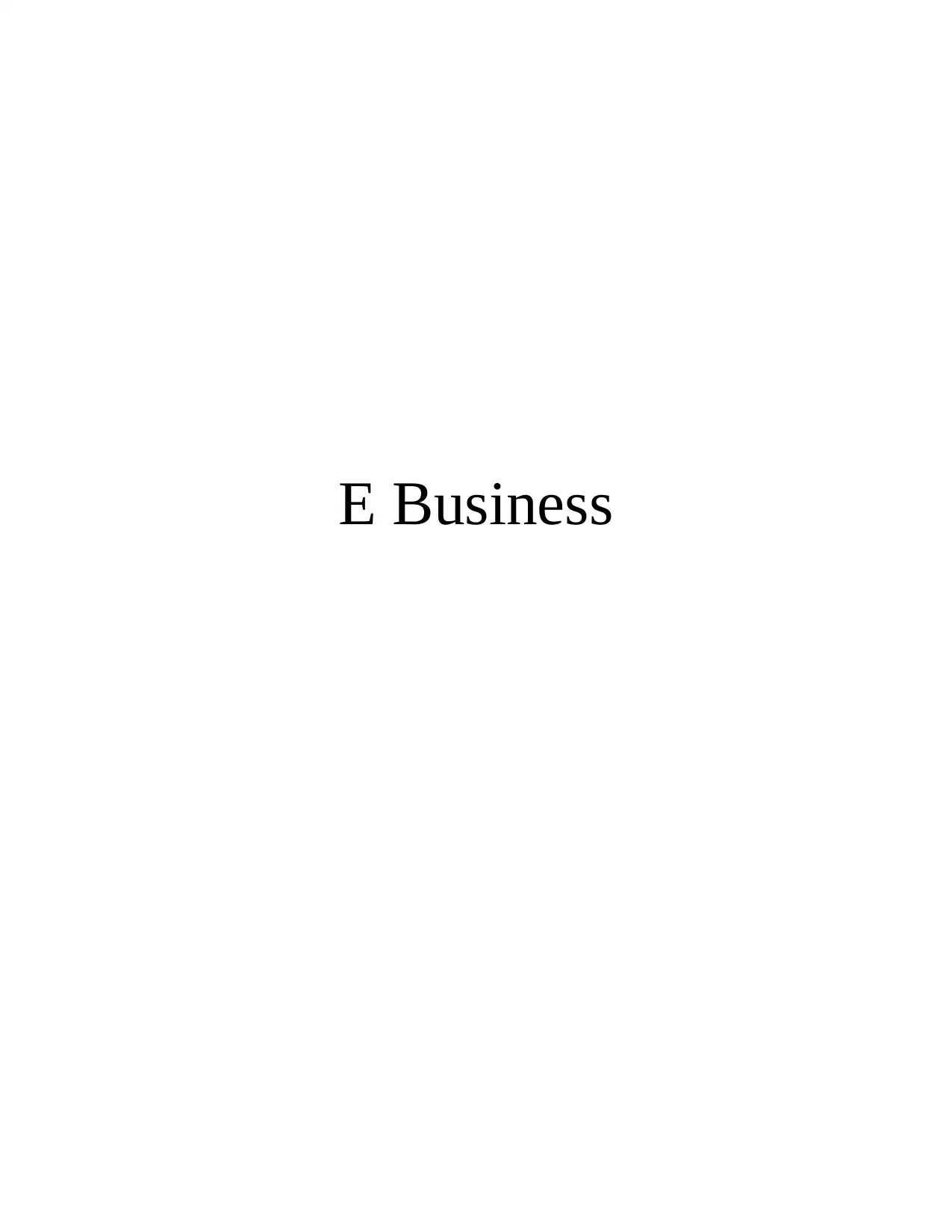
E Business
Paraphrase This Document
Need a fresh take? Get an instant paraphrase of this document with our AI Paraphraser
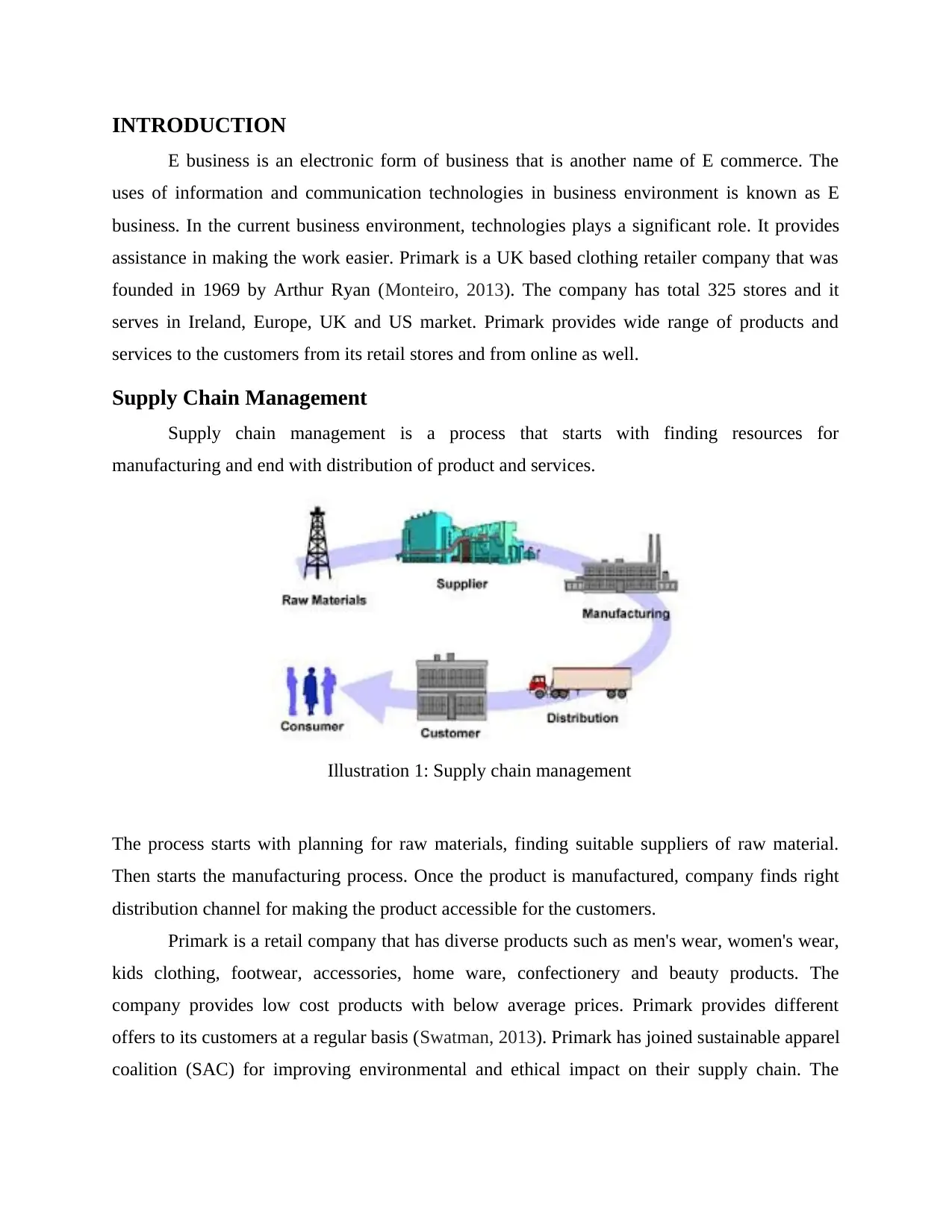
INTRODUCTION
E business is an electronic form of business that is another name of E commerce. The
uses of information and communication technologies in business environment is known as E
business. In the current business environment, technologies plays a significant role. It provides
assistance in making the work easier. Primark is a UK based clothing retailer company that was
founded in 1969 by Arthur Ryan (Monteiro, 2013). The company has total 325 stores and it
serves in Ireland, Europe, UK and US market. Primark provides wide range of products and
services to the customers from its retail stores and from online as well.
Supply Chain Management
Supply chain management is a process that starts with finding resources for
manufacturing and end with distribution of product and services.
The process starts with planning for raw materials, finding suitable suppliers of raw material.
Then starts the manufacturing process. Once the product is manufactured, company finds right
distribution channel for making the product accessible for the customers.
Primark is a retail company that has diverse products such as men's wear, women's wear,
kids clothing, footwear, accessories, home ware, confectionery and beauty products. The
company provides low cost products with below average prices. Primark provides different
offers to its customers at a regular basis (Swatman, 2013). Primark has joined sustainable apparel
coalition (SAC) for improving environmental and ethical impact on their supply chain. The
Illustration 1: Supply chain management
E business is an electronic form of business that is another name of E commerce. The
uses of information and communication technologies in business environment is known as E
business. In the current business environment, technologies plays a significant role. It provides
assistance in making the work easier. Primark is a UK based clothing retailer company that was
founded in 1969 by Arthur Ryan (Monteiro, 2013). The company has total 325 stores and it
serves in Ireland, Europe, UK and US market. Primark provides wide range of products and
services to the customers from its retail stores and from online as well.
Supply Chain Management
Supply chain management is a process that starts with finding resources for
manufacturing and end with distribution of product and services.
The process starts with planning for raw materials, finding suitable suppliers of raw material.
Then starts the manufacturing process. Once the product is manufactured, company finds right
distribution channel for making the product accessible for the customers.
Primark is a retail company that has diverse products such as men's wear, women's wear,
kids clothing, footwear, accessories, home ware, confectionery and beauty products. The
company provides low cost products with below average prices. Primark provides different
offers to its customers at a regular basis (Swatman, 2013). Primark has joined sustainable apparel
coalition (SAC) for improving environmental and ethical impact on their supply chain. The
Illustration 1: Supply chain management
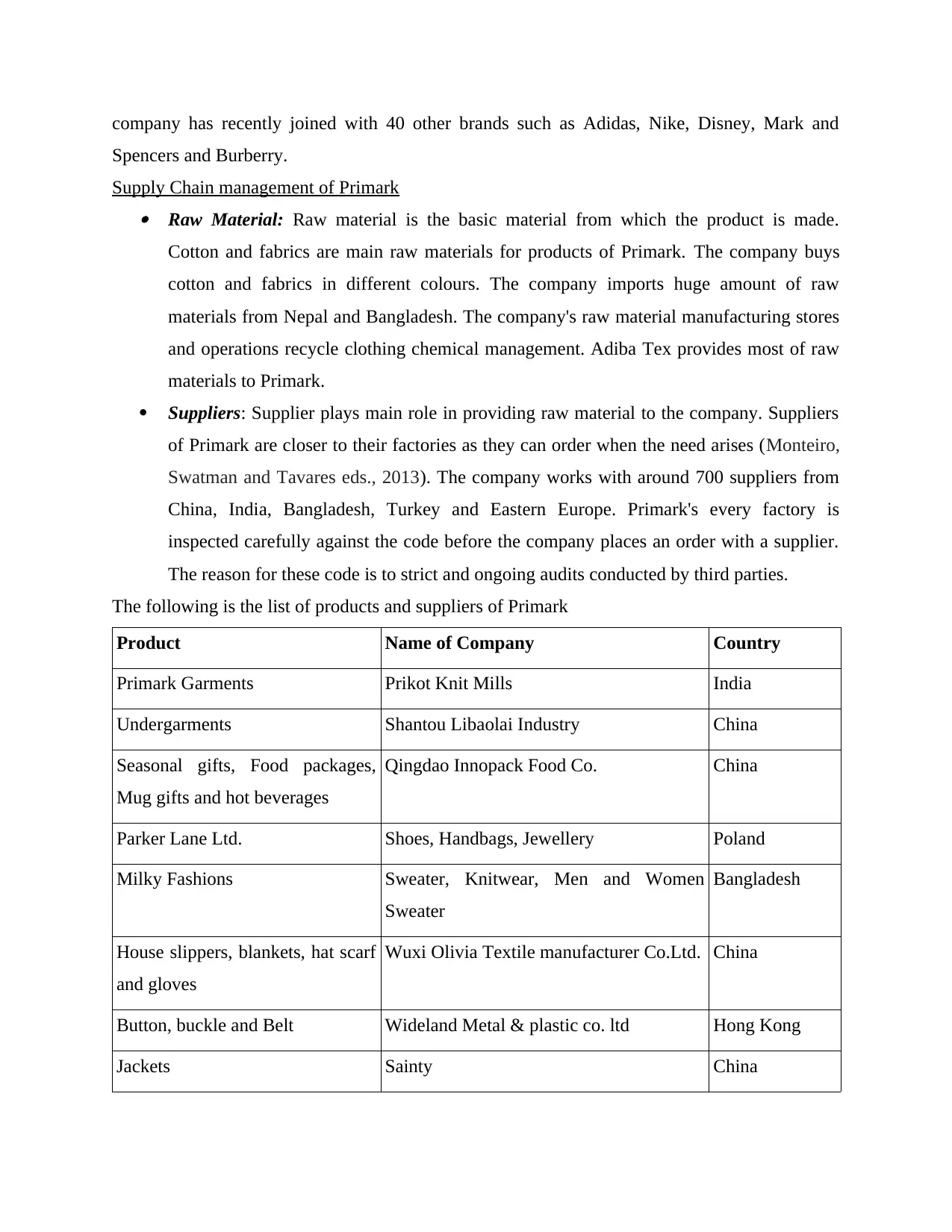
company has recently joined with 40 other brands such as Adidas, Nike, Disney, Mark and
Spencers and Burberry.
Supply Chain management of Primark Raw Material: Raw material is the basic material from which the product is made.
Cotton and fabrics are main raw materials for products of Primark. The company buys
cotton and fabrics in different colours. The company imports huge amount of raw
materials from Nepal and Bangladesh. The company's raw material manufacturing stores
and operations recycle clothing chemical management. Adiba Tex provides most of raw
materials to Primark.
Suppliers: Supplier plays main role in providing raw material to the company. Suppliers
of Primark are closer to their factories as they can order when the need arises (Monteiro,
Swatman and Tavares eds., 2013). The company works with around 700 suppliers from
China, India, Bangladesh, Turkey and Eastern Europe. Primark's every factory is
inspected carefully against the code before the company places an order with a supplier.
The reason for these code is to strict and ongoing audits conducted by third parties.
The following is the list of products and suppliers of Primark
Product Name of Company Country
Primark Garments Prikot Knit Mills India
Undergarments Shantou Libaolai Industry China
Seasonal gifts, Food packages,
Mug gifts and hot beverages
Qingdao Innopack Food Co. China
Parker Lane Ltd. Shoes, Handbags, Jewellery Poland
Milky Fashions Sweater, Knitwear, Men and Women
Sweater
Bangladesh
House slippers, blankets, hat scarf
and gloves
Wuxi Olivia Textile manufacturer Co.Ltd. China
Button, buckle and Belt Wideland Metal & plastic co. ltd Hong Kong
Jackets Sainty China
Spencers and Burberry.
Supply Chain management of Primark Raw Material: Raw material is the basic material from which the product is made.
Cotton and fabrics are main raw materials for products of Primark. The company buys
cotton and fabrics in different colours. The company imports huge amount of raw
materials from Nepal and Bangladesh. The company's raw material manufacturing stores
and operations recycle clothing chemical management. Adiba Tex provides most of raw
materials to Primark.
Suppliers: Supplier plays main role in providing raw material to the company. Suppliers
of Primark are closer to their factories as they can order when the need arises (Monteiro,
Swatman and Tavares eds., 2013). The company works with around 700 suppliers from
China, India, Bangladesh, Turkey and Eastern Europe. Primark's every factory is
inspected carefully against the code before the company places an order with a supplier.
The reason for these code is to strict and ongoing audits conducted by third parties.
The following is the list of products and suppliers of Primark
Product Name of Company Country
Primark Garments Prikot Knit Mills India
Undergarments Shantou Libaolai Industry China
Seasonal gifts, Food packages,
Mug gifts and hot beverages
Qingdao Innopack Food Co. China
Parker Lane Ltd. Shoes, Handbags, Jewellery Poland
Milky Fashions Sweater, Knitwear, Men and Women
Sweater
Bangladesh
House slippers, blankets, hat scarf
and gloves
Wuxi Olivia Textile manufacturer Co.Ltd. China
Button, buckle and Belt Wideland Metal & plastic co. ltd Hong Kong
Jackets Sainty China
⊘ This is a preview!⊘
Do you want full access?
Subscribe today to unlock all pages.

Trusted by 1+ million students worldwide
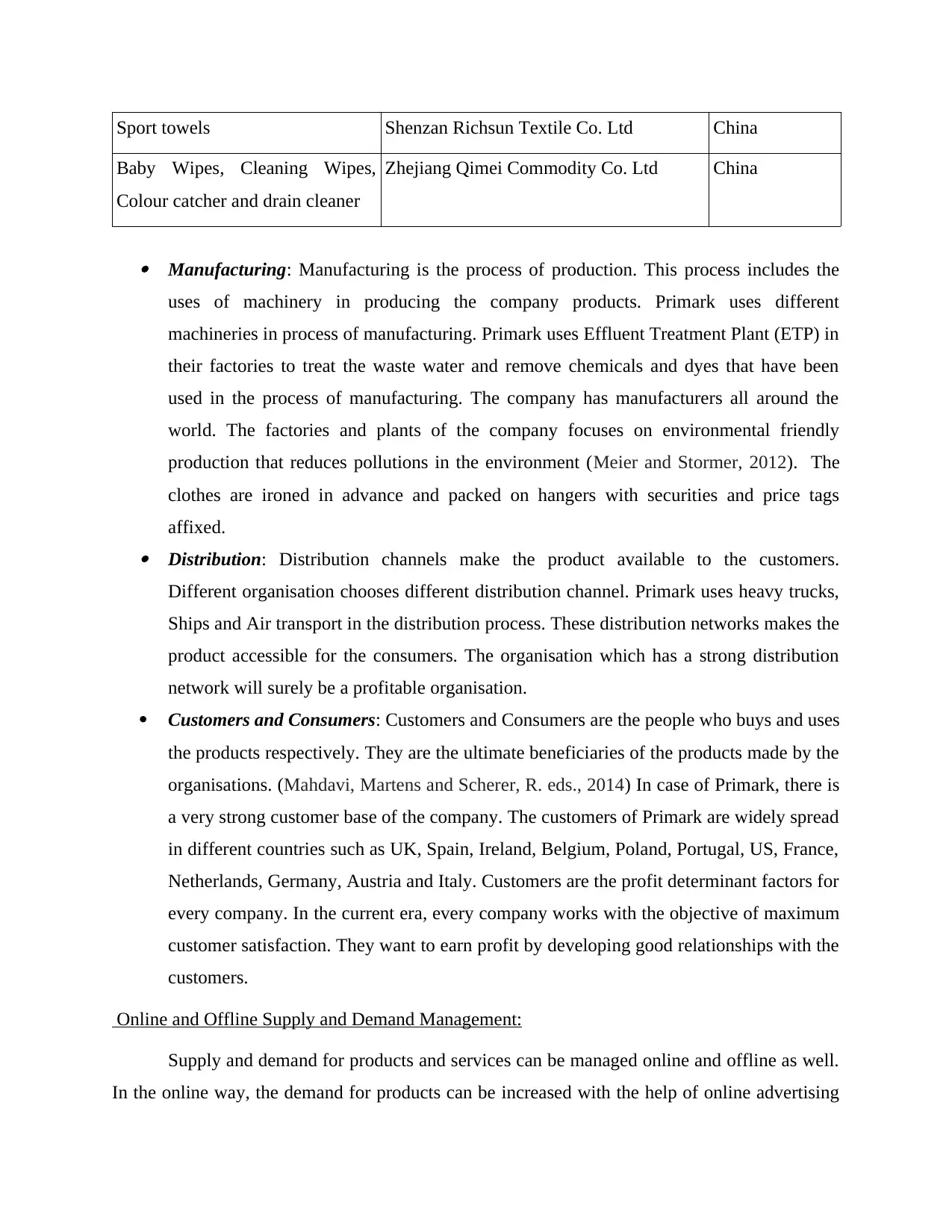
Sport towels Shenzan Richsun Textile Co. Ltd China
Baby Wipes, Cleaning Wipes,
Colour catcher and drain cleaner
Zhejiang Qimei Commodity Co. Ltd China
Manufacturing: Manufacturing is the process of production. This process includes the
uses of machinery in producing the company products. Primark uses different
machineries in process of manufacturing. Primark uses Effluent Treatment Plant (ETP) in
their factories to treat the waste water and remove chemicals and dyes that have been
used in the process of manufacturing. The company has manufacturers all around the
world. The factories and plants of the company focuses on environmental friendly
production that reduces pollutions in the environment (Meier and Stormer, 2012). The
clothes are ironed in advance and packed on hangers with securities and price tags
affixed. Distribution: Distribution channels make the product available to the customers.
Different organisation chooses different distribution channel. Primark uses heavy trucks,
Ships and Air transport in the distribution process. These distribution networks makes the
product accessible for the consumers. The organisation which has a strong distribution
network will surely be a profitable organisation.
Customers and Consumers: Customers and Consumers are the people who buys and uses
the products respectively. They are the ultimate beneficiaries of the products made by the
organisations. (Mahdavi, Martens and Scherer, R. eds., 2014) In case of Primark, there is
a very strong customer base of the company. The customers of Primark are widely spread
in different countries such as UK, Spain, Ireland, Belgium, Poland, Portugal, US, France,
Netherlands, Germany, Austria and Italy. Customers are the profit determinant factors for
every company. In the current era, every company works with the objective of maximum
customer satisfaction. They want to earn profit by developing good relationships with the
customers.
Online and Offline Supply and Demand Management:
Supply and demand for products and services can be managed online and offline as well.
In the online way, the demand for products can be increased with the help of online advertising
Baby Wipes, Cleaning Wipes,
Colour catcher and drain cleaner
Zhejiang Qimei Commodity Co. Ltd China
Manufacturing: Manufacturing is the process of production. This process includes the
uses of machinery in producing the company products. Primark uses different
machineries in process of manufacturing. Primark uses Effluent Treatment Plant (ETP) in
their factories to treat the waste water and remove chemicals and dyes that have been
used in the process of manufacturing. The company has manufacturers all around the
world. The factories and plants of the company focuses on environmental friendly
production that reduces pollutions in the environment (Meier and Stormer, 2012). The
clothes are ironed in advance and packed on hangers with securities and price tags
affixed. Distribution: Distribution channels make the product available to the customers.
Different organisation chooses different distribution channel. Primark uses heavy trucks,
Ships and Air transport in the distribution process. These distribution networks makes the
product accessible for the consumers. The organisation which has a strong distribution
network will surely be a profitable organisation.
Customers and Consumers: Customers and Consumers are the people who buys and uses
the products respectively. They are the ultimate beneficiaries of the products made by the
organisations. (Mahdavi, Martens and Scherer, R. eds., 2014) In case of Primark, there is
a very strong customer base of the company. The customers of Primark are widely spread
in different countries such as UK, Spain, Ireland, Belgium, Poland, Portugal, US, France,
Netherlands, Germany, Austria and Italy. Customers are the profit determinant factors for
every company. In the current era, every company works with the objective of maximum
customer satisfaction. They want to earn profit by developing good relationships with the
customers.
Online and Offline Supply and Demand Management:
Supply and demand for products and services can be managed online and offline as well.
In the online way, the demand for products can be increased with the help of online advertising
Paraphrase This Document
Need a fresh take? Get an instant paraphrase of this document with our AI Paraphraser
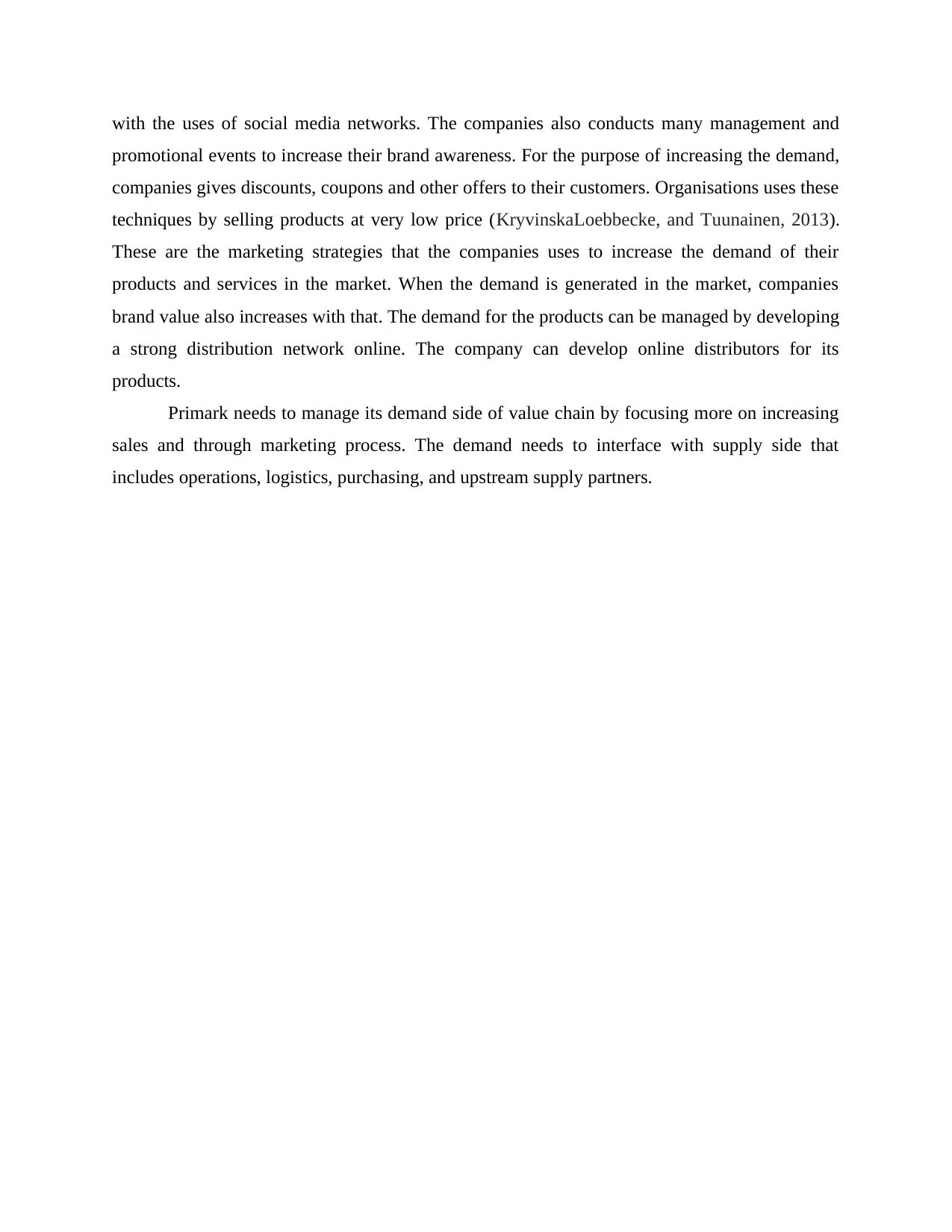
with the uses of social media networks. The companies also conducts many management and
promotional events to increase their brand awareness. For the purpose of increasing the demand,
companies gives discounts, coupons and other offers to their customers. Organisations uses these
techniques by selling products at very low price (KryvinskaLoebbecke, and Tuunainen, 2013).
These are the marketing strategies that the companies uses to increase the demand of their
products and services in the market. When the demand is generated in the market, companies
brand value also increases with that. The demand for the products can be managed by developing
a strong distribution network online. The company can develop online distributors for its
products.
Primark needs to manage its demand side of value chain by focusing more on increasing
sales and through marketing process. The demand needs to interface with supply side that
includes operations, logistics, purchasing, and upstream supply partners.
promotional events to increase their brand awareness. For the purpose of increasing the demand,
companies gives discounts, coupons and other offers to their customers. Organisations uses these
techniques by selling products at very low price (KryvinskaLoebbecke, and Tuunainen, 2013).
These are the marketing strategies that the companies uses to increase the demand of their
products and services in the market. When the demand is generated in the market, companies
brand value also increases with that. The demand for the products can be managed by developing
a strong distribution network online. The company can develop online distributors for its
products.
Primark needs to manage its demand side of value chain by focusing more on increasing
sales and through marketing process. The demand needs to interface with supply side that
includes operations, logistics, purchasing, and upstream supply partners.
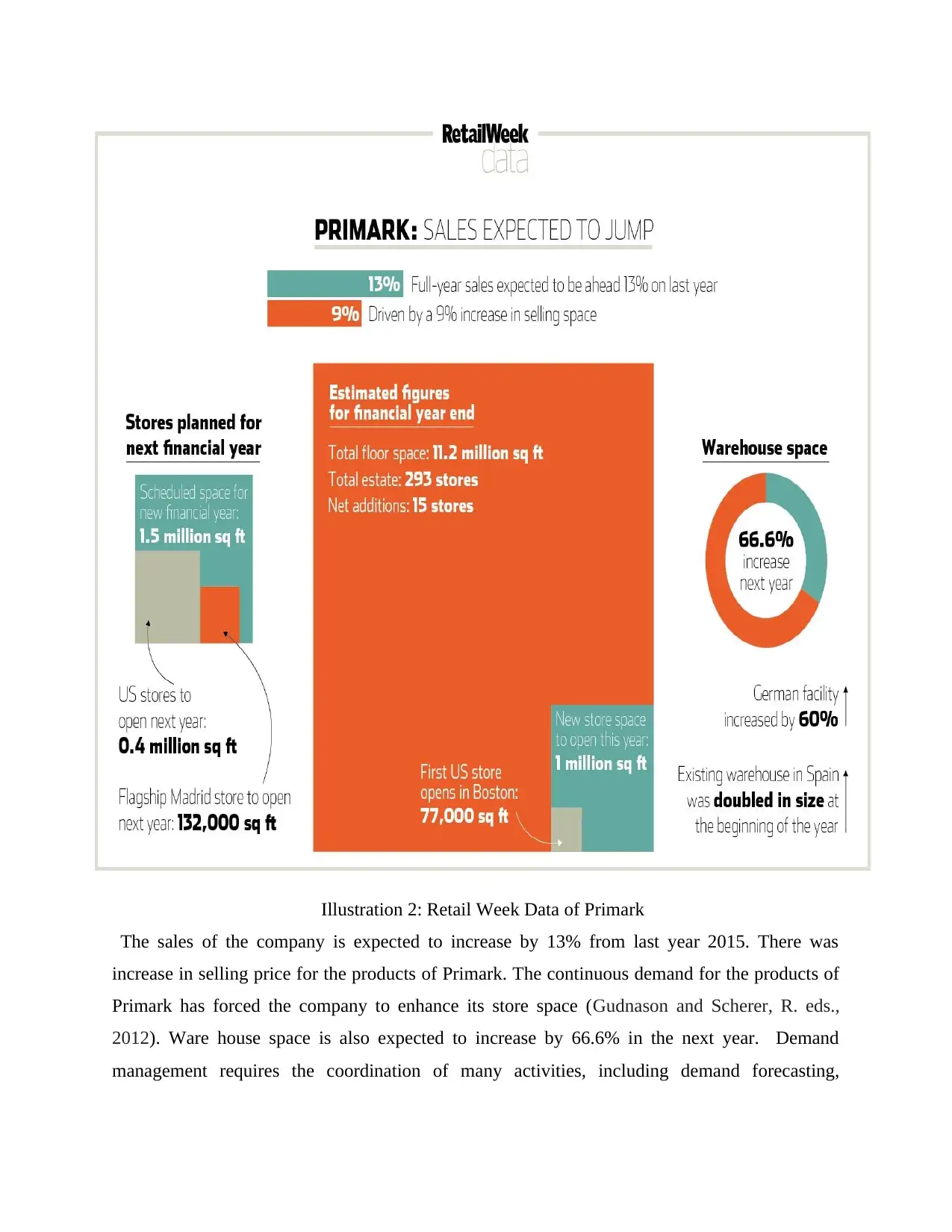
The sales of the company is expected to increase by 13% from last year 2015. There was
increase in selling price for the products of Primark. The continuous demand for the products of
Primark has forced the company to enhance its store space (Gudnason and Scherer, R. eds.,
2012). Ware house space is also expected to increase by 66.6% in the next year. Demand
management requires the coordination of many activities, including demand forecasting,
Illustration 2: Retail Week Data of Primark
increase in selling price for the products of Primark. The continuous demand for the products of
Primark has forced the company to enhance its store space (Gudnason and Scherer, R. eds.,
2012). Ware house space is also expected to increase by 66.6% in the next year. Demand
management requires the coordination of many activities, including demand forecasting,
Illustration 2: Retail Week Data of Primark
⊘ This is a preview!⊘
Do you want full access?
Subscribe today to unlock all pages.

Trusted by 1+ million students worldwide
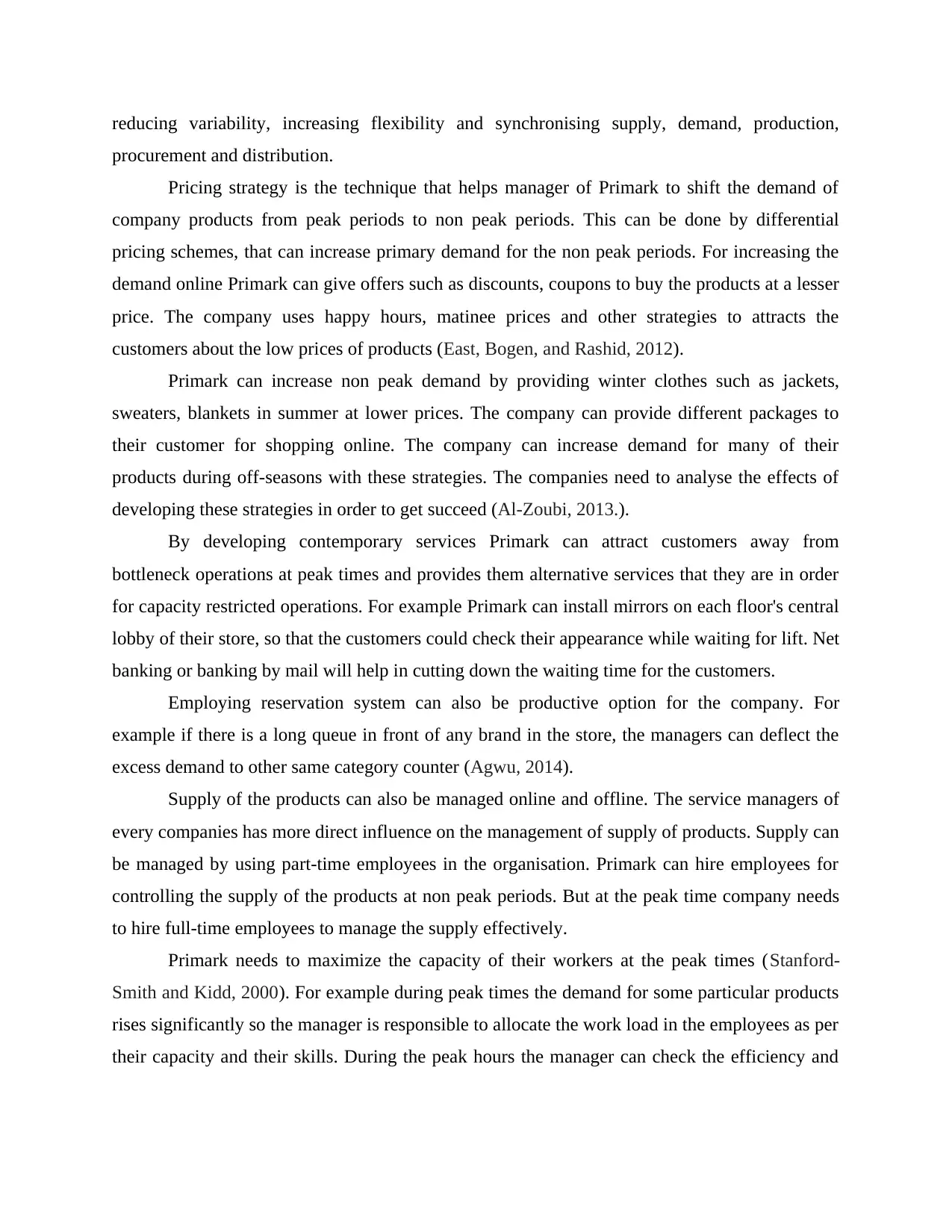
reducing variability, increasing flexibility and synchronising supply, demand, production,
procurement and distribution.
Pricing strategy is the technique that helps manager of Primark to shift the demand of
company products from peak periods to non peak periods. This can be done by differential
pricing schemes, that can increase primary demand for the non peak periods. For increasing the
demand online Primark can give offers such as discounts, coupons to buy the products at a lesser
price. The company uses happy hours, matinee prices and other strategies to attracts the
customers about the low prices of products (East, Bogen, and Rashid, 2012).
Primark can increase non peak demand by providing winter clothes such as jackets,
sweaters, blankets in summer at lower prices. The company can provide different packages to
their customer for shopping online. The company can increase demand for many of their
products during off-seasons with these strategies. The companies need to analyse the effects of
developing these strategies in order to get succeed (Al-Zoubi, 2013.).
By developing contemporary services Primark can attract customers away from
bottleneck operations at peak times and provides them alternative services that they are in order
for capacity restricted operations. For example Primark can install mirrors on each floor's central
lobby of their store, so that the customers could check their appearance while waiting for lift. Net
banking or banking by mail will help in cutting down the waiting time for the customers.
Employing reservation system can also be productive option for the company. For
example if there is a long queue in front of any brand in the store, the managers can deflect the
excess demand to other same category counter (Agwu, 2014).
Supply of the products can also be managed online and offline. The service managers of
every companies has more direct influence on the management of supply of products. Supply can
be managed by using part-time employees in the organisation. Primark can hire employees for
controlling the supply of the products at non peak periods. But at the peak time company needs
to hire full-time employees to manage the supply effectively.
Primark needs to maximize the capacity of their workers at the peak times (Stanford-
Smith and Kidd, 2000). For example during peak times the demand for some particular products
rises significantly so the manager is responsible to allocate the work load in the employees as per
their capacity and their skills. During the peak hours the manager can check the efficiency and
procurement and distribution.
Pricing strategy is the technique that helps manager of Primark to shift the demand of
company products from peak periods to non peak periods. This can be done by differential
pricing schemes, that can increase primary demand for the non peak periods. For increasing the
demand online Primark can give offers such as discounts, coupons to buy the products at a lesser
price. The company uses happy hours, matinee prices and other strategies to attracts the
customers about the low prices of products (East, Bogen, and Rashid, 2012).
Primark can increase non peak demand by providing winter clothes such as jackets,
sweaters, blankets in summer at lower prices. The company can provide different packages to
their customer for shopping online. The company can increase demand for many of their
products during off-seasons with these strategies. The companies need to analyse the effects of
developing these strategies in order to get succeed (Al-Zoubi, 2013.).
By developing contemporary services Primark can attract customers away from
bottleneck operations at peak times and provides them alternative services that they are in order
for capacity restricted operations. For example Primark can install mirrors on each floor's central
lobby of their store, so that the customers could check their appearance while waiting for lift. Net
banking or banking by mail will help in cutting down the waiting time for the customers.
Employing reservation system can also be productive option for the company. For
example if there is a long queue in front of any brand in the store, the managers can deflect the
excess demand to other same category counter (Agwu, 2014).
Supply of the products can also be managed online and offline. The service managers of
every companies has more direct influence on the management of supply of products. Supply can
be managed by using part-time employees in the organisation. Primark can hire employees for
controlling the supply of the products at non peak periods. But at the peak time company needs
to hire full-time employees to manage the supply effectively.
Primark needs to maximize the capacity of their workers at the peak times (Stanford-
Smith and Kidd, 2000). For example during peak times the demand for some particular products
rises significantly so the manager is responsible to allocate the work load in the employees as per
their capacity and their skills. During the peak hours the manager can check the efficiency and
Paraphrase This Document
Need a fresh take? Get an instant paraphrase of this document with our AI Paraphraser
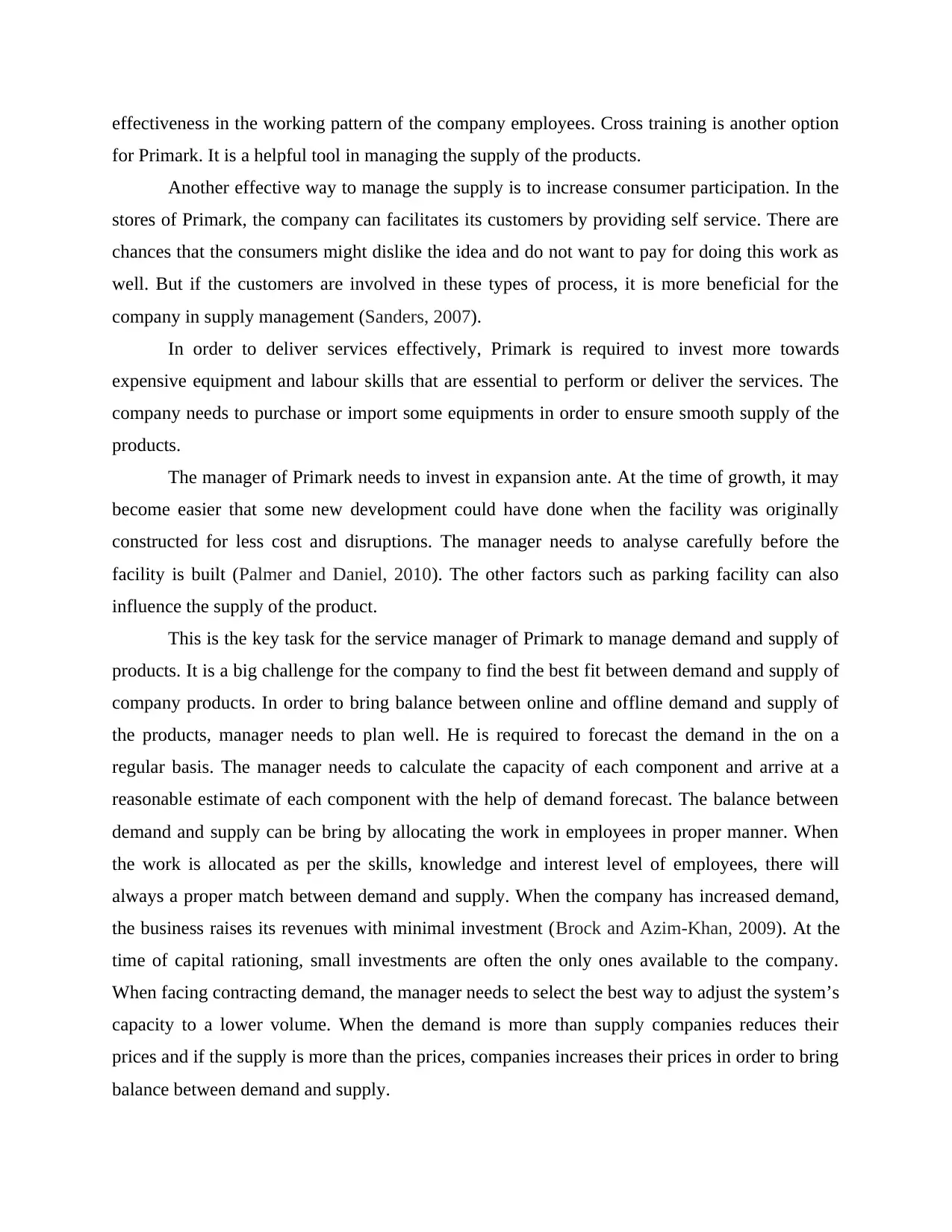
effectiveness in the working pattern of the company employees. Cross training is another option
for Primark. It is a helpful tool in managing the supply of the products.
Another effective way to manage the supply is to increase consumer participation. In the
stores of Primark, the company can facilitates its customers by providing self service. There are
chances that the consumers might dislike the idea and do not want to pay for doing this work as
well. But if the customers are involved in these types of process, it is more beneficial for the
company in supply management (Sanders, 2007).
In order to deliver services effectively, Primark is required to invest more towards
expensive equipment and labour skills that are essential to perform or deliver the services. The
company needs to purchase or import some equipments in order to ensure smooth supply of the
products.
The manager of Primark needs to invest in expansion ante. At the time of growth, it may
become easier that some new development could have done when the facility was originally
constructed for less cost and disruptions. The manager needs to analyse carefully before the
facility is built (Palmer and Daniel, 2010). The other factors such as parking facility can also
influence the supply of the product.
This is the key task for the service manager of Primark to manage demand and supply of
products. It is a big challenge for the company to find the best fit between demand and supply of
company products. In order to bring balance between online and offline demand and supply of
the products, manager needs to plan well. He is required to forecast the demand in the on a
regular basis. The manager needs to calculate the capacity of each component and arrive at a
reasonable estimate of each component with the help of demand forecast. The balance between
demand and supply can be bring by allocating the work in employees in proper manner. When
the work is allocated as per the skills, knowledge and interest level of employees, there will
always a proper match between demand and supply. When the company has increased demand,
the business raises its revenues with minimal investment (Brock and Azim-Khan, 2009). At the
time of capital rationing, small investments are often the only ones available to the company.
When facing contracting demand, the manager needs to select the best way to adjust the system’s
capacity to a lower volume. When the demand is more than supply companies reduces their
prices and if the supply is more than the prices, companies increases their prices in order to bring
balance between demand and supply.
for Primark. It is a helpful tool in managing the supply of the products.
Another effective way to manage the supply is to increase consumer participation. In the
stores of Primark, the company can facilitates its customers by providing self service. There are
chances that the consumers might dislike the idea and do not want to pay for doing this work as
well. But if the customers are involved in these types of process, it is more beneficial for the
company in supply management (Sanders, 2007).
In order to deliver services effectively, Primark is required to invest more towards
expensive equipment and labour skills that are essential to perform or deliver the services. The
company needs to purchase or import some equipments in order to ensure smooth supply of the
products.
The manager of Primark needs to invest in expansion ante. At the time of growth, it may
become easier that some new development could have done when the facility was originally
constructed for less cost and disruptions. The manager needs to analyse carefully before the
facility is built (Palmer and Daniel, 2010). The other factors such as parking facility can also
influence the supply of the product.
This is the key task for the service manager of Primark to manage demand and supply of
products. It is a big challenge for the company to find the best fit between demand and supply of
company products. In order to bring balance between online and offline demand and supply of
the products, manager needs to plan well. He is required to forecast the demand in the on a
regular basis. The manager needs to calculate the capacity of each component and arrive at a
reasonable estimate of each component with the help of demand forecast. The balance between
demand and supply can be bring by allocating the work in employees in proper manner. When
the work is allocated as per the skills, knowledge and interest level of employees, there will
always a proper match between demand and supply. When the company has increased demand,
the business raises its revenues with minimal investment (Brock and Azim-Khan, 2009). At the
time of capital rationing, small investments are often the only ones available to the company.
When facing contracting demand, the manager needs to select the best way to adjust the system’s
capacity to a lower volume. When the demand is more than supply companies reduces their
prices and if the supply is more than the prices, companies increases their prices in order to bring
balance between demand and supply.
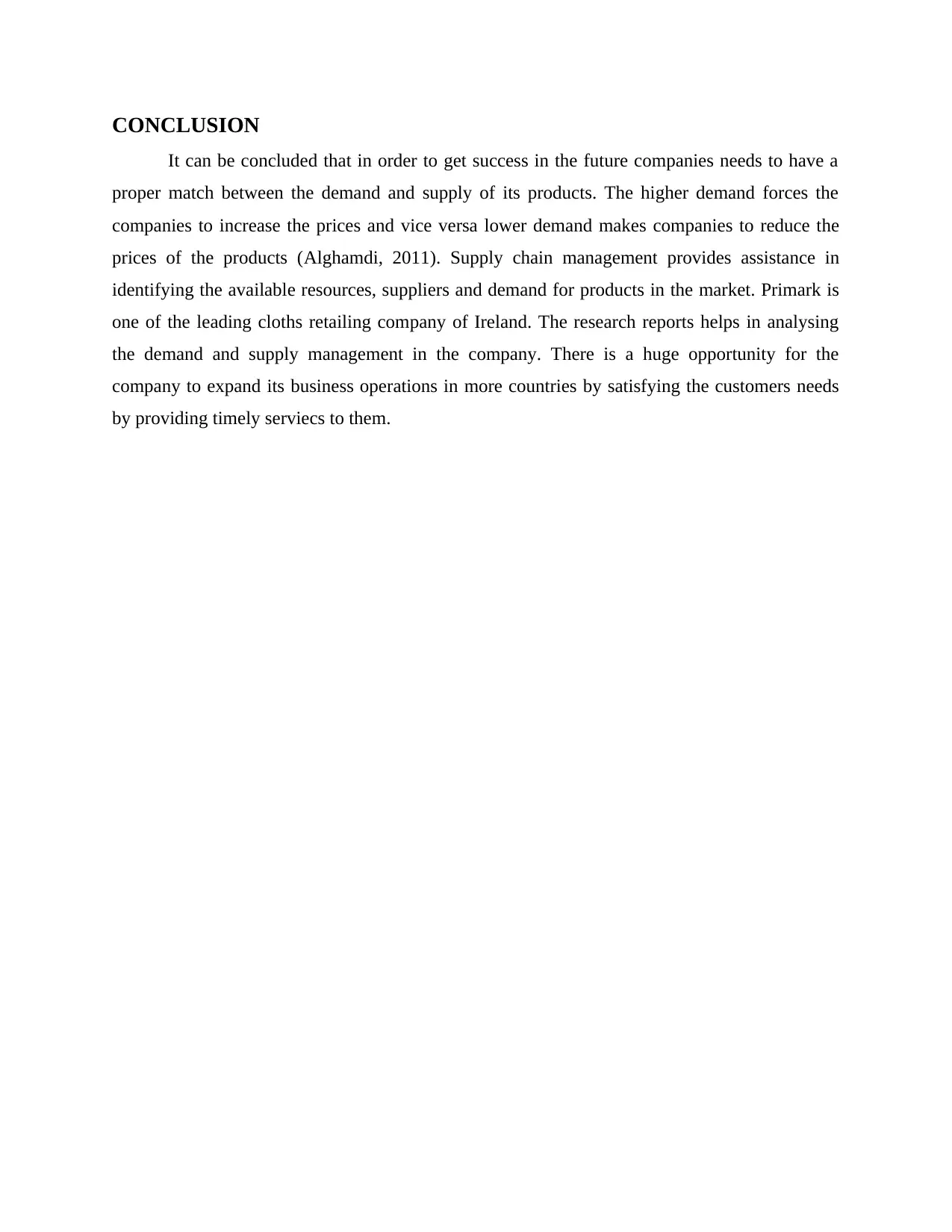
CONCLUSION
It can be concluded that in order to get success in the future companies needs to have a
proper match between the demand and supply of its products. The higher demand forces the
companies to increase the prices and vice versa lower demand makes companies to reduce the
prices of the products (Alghamdi, 2011). Supply chain management provides assistance in
identifying the available resources, suppliers and demand for products in the market. Primark is
one of the leading cloths retailing company of Ireland. The research reports helps in analysing
the demand and supply management in the company. There is a huge opportunity for the
company to expand its business operations in more countries by satisfying the customers needs
by providing timely serviecs to them.
It can be concluded that in order to get success in the future companies needs to have a
proper match between the demand and supply of its products. The higher demand forces the
companies to increase the prices and vice versa lower demand makes companies to reduce the
prices of the products (Alghamdi, 2011). Supply chain management provides assistance in
identifying the available resources, suppliers and demand for products in the market. Primark is
one of the leading cloths retailing company of Ireland. The research reports helps in analysing
the demand and supply management in the company. There is a huge opportunity for the
company to expand its business operations in more countries by satisfying the customers needs
by providing timely serviecs to them.
⊘ This is a preview!⊘
Do you want full access?
Subscribe today to unlock all pages.

Trusted by 1+ million students worldwide
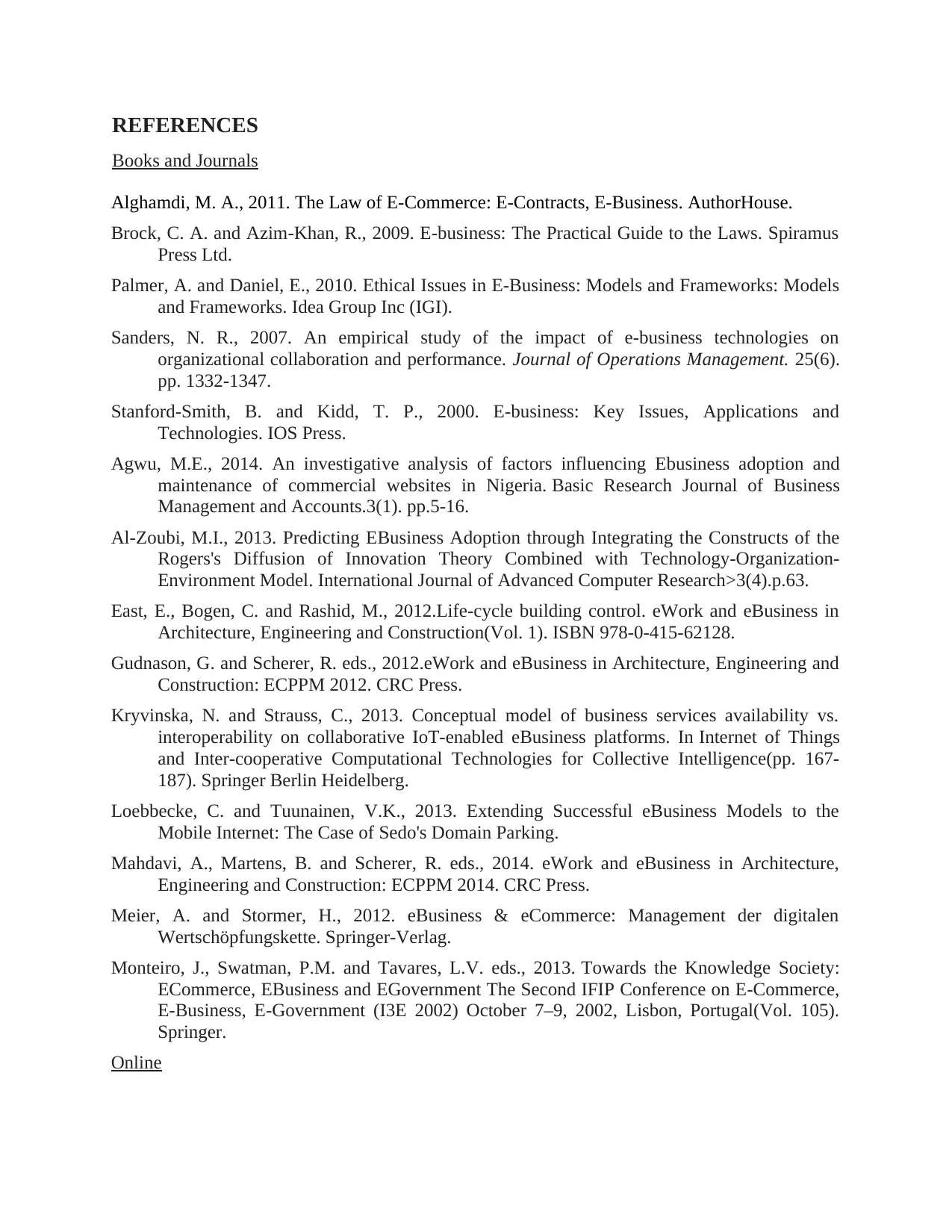
REFERENCES
Books and Journals
Alghamdi, M. A., 2011. The Law of E-Commerce: E-Contracts, E-Business. AuthorHouse.
Brock, C. A. and Azim-Khan, R., 2009. E-business: The Practical Guide to the Laws. Spiramus
Press Ltd.
Palmer, A. and Daniel, E., 2010. Ethical Issues in E-Business: Models and Frameworks: Models
and Frameworks. Idea Group Inc (IGI).
Sanders, N. R., 2007. An empirical study of the impact of e-business technologies on
organizational collaboration and performance. Journal of Operations Management. 25(6).
pp. 1332-1347.
Stanford-Smith, B. and Kidd, T. P., 2000. E-business: Key Issues, Applications and
Technologies. IOS Press.
Agwu, M.E., 2014. An investigative analysis of factors influencing Ebusiness adoption and
maintenance of commercial websites in Nigeria. Basic Research Journal of Business
Management and Accounts.3(1). pp.5-16.
Al-Zoubi, M.I., 2013. Predicting EBusiness Adoption through Integrating the Constructs of the
Rogers's Diffusion of Innovation Theory Combined with Technology-Organization-
Environment Model. International Journal of Advanced Computer Research>3(4).p.63.
East, E., Bogen, C. and Rashid, M., 2012.Life-cycle building control. eWork and eBusiness in
Architecture, Engineering and Construction(Vol. 1). ISBN 978-0-415-62128.
Gudnason, G. and Scherer, R. eds., 2012.eWork and eBusiness in Architecture, Engineering and
Construction: ECPPM 2012. CRC Press.
Kryvinska, N. and Strauss, C., 2013. Conceptual model of business services availability vs.
interoperability on collaborative IoT-enabled eBusiness platforms. In Internet of Things
and Inter-cooperative Computational Technologies for Collective Intelligence(pp. 167-
187). Springer Berlin Heidelberg.
Loebbecke, C. and Tuunainen, V.K., 2013. Extending Successful eBusiness Models to the
Mobile Internet: The Case of Sedo's Domain Parking.
Mahdavi, A., Martens, B. and Scherer, R. eds., 2014. eWork and eBusiness in Architecture,
Engineering and Construction: ECPPM 2014. CRC Press.
Meier, A. and Stormer, H., 2012. eBusiness & eCommerce: Management der digitalen
Wertschöpfungskette. Springer-Verlag.
Monteiro, J., Swatman, P.M. and Tavares, L.V. eds., 2013. Towards the Knowledge Society:
ECommerce, EBusiness and EGovernment The Second IFIP Conference on E-Commerce,
E-Business, E-Government (I3E 2002) October 7–9, 2002, Lisbon, Portugal(Vol. 105).
Springer.
Online
Books and Journals
Alghamdi, M. A., 2011. The Law of E-Commerce: E-Contracts, E-Business. AuthorHouse.
Brock, C. A. and Azim-Khan, R., 2009. E-business: The Practical Guide to the Laws. Spiramus
Press Ltd.
Palmer, A. and Daniel, E., 2010. Ethical Issues in E-Business: Models and Frameworks: Models
and Frameworks. Idea Group Inc (IGI).
Sanders, N. R., 2007. An empirical study of the impact of e-business technologies on
organizational collaboration and performance. Journal of Operations Management. 25(6).
pp. 1332-1347.
Stanford-Smith, B. and Kidd, T. P., 2000. E-business: Key Issues, Applications and
Technologies. IOS Press.
Agwu, M.E., 2014. An investigative analysis of factors influencing Ebusiness adoption and
maintenance of commercial websites in Nigeria. Basic Research Journal of Business
Management and Accounts.3(1). pp.5-16.
Al-Zoubi, M.I., 2013. Predicting EBusiness Adoption through Integrating the Constructs of the
Rogers's Diffusion of Innovation Theory Combined with Technology-Organization-
Environment Model. International Journal of Advanced Computer Research>3(4).p.63.
East, E., Bogen, C. and Rashid, M., 2012.Life-cycle building control. eWork and eBusiness in
Architecture, Engineering and Construction(Vol. 1). ISBN 978-0-415-62128.
Gudnason, G. and Scherer, R. eds., 2012.eWork and eBusiness in Architecture, Engineering and
Construction: ECPPM 2012. CRC Press.
Kryvinska, N. and Strauss, C., 2013. Conceptual model of business services availability vs.
interoperability on collaborative IoT-enabled eBusiness platforms. In Internet of Things
and Inter-cooperative Computational Technologies for Collective Intelligence(pp. 167-
187). Springer Berlin Heidelberg.
Loebbecke, C. and Tuunainen, V.K., 2013. Extending Successful eBusiness Models to the
Mobile Internet: The Case of Sedo's Domain Parking.
Mahdavi, A., Martens, B. and Scherer, R. eds., 2014. eWork and eBusiness in Architecture,
Engineering and Construction: ECPPM 2014. CRC Press.
Meier, A. and Stormer, H., 2012. eBusiness & eCommerce: Management der digitalen
Wertschöpfungskette. Springer-Verlag.
Monteiro, J., Swatman, P.M. and Tavares, L.V. eds., 2013. Towards the Knowledge Society:
ECommerce, EBusiness and EGovernment The Second IFIP Conference on E-Commerce,
E-Business, E-Government (I3E 2002) October 7–9, 2002, Lisbon, Portugal(Vol. 105).
Springer.
Online
Paraphrase This Document
Need a fresh take? Get an instant paraphrase of this document with our AI Paraphraser

Benefits of EDI. 2015. Available through: <http://www.edibasics.com/benefits-of-edi/>.
[Accessed on 15th November 2016].
Coltman, T., Devinney, M. T. and Latukefu, A., 2010. E-Business: Revolution, Evolution, or
Hype. [Online]. Available through: <http://ro.uow.edu.au/cgi/viewcontent.cgi?
article=1691&context=infopapers>. [Accessed on 15th November 2016].
[Accessed on 15th November 2016].
Coltman, T., Devinney, M. T. and Latukefu, A., 2010. E-Business: Revolution, Evolution, or
Hype. [Online]. Available through: <http://ro.uow.edu.au/cgi/viewcontent.cgi?
article=1691&context=infopapers>. [Accessed on 15th November 2016].
1 out of 11
Related Documents
Your All-in-One AI-Powered Toolkit for Academic Success.
+13062052269
info@desklib.com
Available 24*7 on WhatsApp / Email
![[object Object]](/_next/static/media/star-bottom.7253800d.svg)
Unlock your academic potential
Copyright © 2020–2025 A2Z Services. All Rights Reserved. Developed and managed by ZUCOL.





